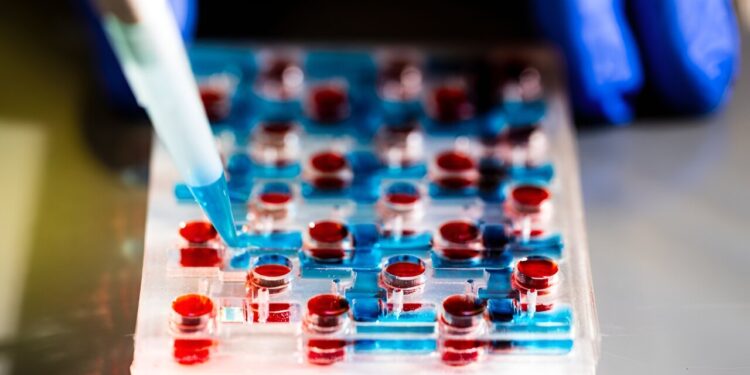Chemical engineering professors Abigail and Ryan Koppes built a model that mimics the functioning of vital neurons in the small intestine. Credit: Alyssa Stone/Northeastern University
The relationship between our nervous and digestive systems is a relatively new area of scientific study. But what Abigail Koppes, a researcher at Northeastern University, calls the “brain-gut” connection has broad implications for our overall health that we are just beginning to understand.
“It’s a complex network,” says Koppes, associate professor of chemical engineering. “We know, for example, that people with autism, Parkinson’s disease or Alzheimer’s disease often suffer from intestinal dysfunction. We know that people with Crohn’s disease, ulcerative colitis or IBS (irritable bowel syndrome) are often co-present with anxiety or depression. Until around 2018, no one had really proven these links existed.
In their lab, Koppes and fellow associate professor of chemical engineering Ryan Koppes (her husband) are building tiny structural models that will help elucidate these connections.
In September, the Koppeses, along with Ph.D. students Kyla Kaiser and Jessica Snyder (both now graduates), published an article in the journal Advanced functional materials describing the construction of a 3D model that simulates interactions in the human small intestine. Specifically, their model aims to take a closer look at enteric neurons: nerve cells that keep things running smoothly in the intestinal tract.
The Koppes model, a dozen of which fit on a postcard-sized plastic platform, is one of a growing number of sophisticated organ models designed to study processes within the human body.
The most avant-garde combine synthetic elements with living fabrics. The microdevices, called “organs-on-a-chip,” are designed to mimic the function and structure of human organs like the heart and lungs. They can be used to study a range of biological processes, from the delivery of drugs to parts of the body to the progression of disease.
“Intestinal models are popular development targets because of their applications in pharmaceutical development: drugs, nutrients and other things absorbed orally,” says Abby Koppes.
By adding neurons, the Koppes’ research goes even further in modeling the intestine on a chip. “Enteric neurons play an essential role in maintaining homeostasis of small intestinal organs, and their dysregulation is implicated in gastrointestinal disorders and neurodegenerative diseases,” the article abstract states.
“Adding neurons is critical to the development of more complex and biomimetic organ chips, especially as they become the standard for studying developmental biology, drug delivery and disease progression.”
Credit: Alyssa Stone/Northeastern University
The structure uses synthetic materials that you might find in a home aquarium (“We make everything layer by layer and so it’s a combination of different thermoplastics and duct tape,” says Ryan Koppes.) to house the living cellular tissues, from rodents in this case, but the model can be adapted to human neurons.
“In this article, we used cells directly from the intestine,” explains Abby Koppes.
“We isolate epithelial cells, which are kind of like, you know, the cells on the outside of your skin that protect your body, but in your gut you have the same thing. This system is used to protect your body pathogens that interact with you with your microbiota, your food and everything. These are the cells that we want to study because they are very important for sensing the outside world and sending information back to your body, and your nervous system in the. intestine is located just below.
“Including the nervous system is really challenging, because we know it can control how the gut works,” she continues. “Without that, we consider these models to be really lacking.”
Abby Koppes’ research focuses on tissue engineering and the nervous system; she began her research on the gut as a collaborator in Rebecca Carrier’s lab at Northeastern. Ryan Koppes’ team is taking on more of the technical aspects of the collaboration, adding instrumentation and engineering biomaterials. They’ve been working on this organ-on-a-chip model since Abby arrived on campus in Boston.
“This project was launched when the laboratory started in 2014,” she explains. “It’s something I talked about in my chalk talks to try to get the job here. So it’s been a dream over the last decade, really, to make this happen .”
The Koppes see this model as a starting point for building increasingly complex models of the brain-gut connection, with diverse applications.
“We’ve done all this work to build the system. Now we can start manipulating it,” says Abby Koppes. “We also study Alzheimer’s disease and Parkinson’s disease, but we’re also interested in things like environmental toxins and everlasting chemicals. We can apply the system to ask questions about how our bodies interact with our environment.”
Ryan Koppes believes that because the system is small and can be replicated efficiently with single cells, there is also potential for drug therapies.
“As we start to think about human diseases, testing new compounds for toxicity and therapeutic efficacy is a huge selling point,” he says. “I think with these systems we will eventually be able to create a patient-by-patient platform to actually test different drugs and disease pathways.”
More information:
Kyla N. Kaiser et al, A high-flow pump-free microphysiological system to mimic enteric innervation of duodenal epithelium and the impact on barrier function, Advanced functional materials (2024). DOI: 10.1002/adfm.202409718
Provided by Northeastern University
This story is republished courtesy of Northeastern Global News news.northeastern.edu.
Quote: What a 3D small intestine can tell us about gastrointestinal disorders (October 10, 2024) retrieved October 10, 2024 from
This document is subject to copyright. Except for fair use for private study or research purposes, no part may be reproduced without written permission. The content is provided for informational purposes only.



